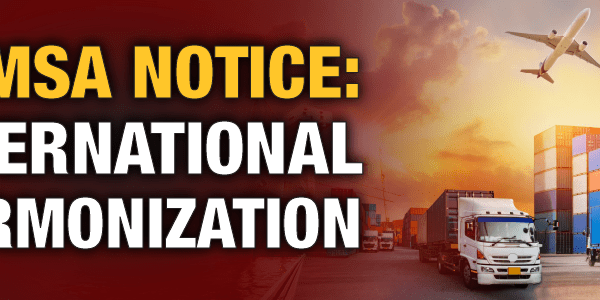This post was originally published in March 2017 and has been updated in September 2020 for accuracy.

Answers from the Helpdesk
Placarding is one of the more complicated areas of the hazardous materials regulations. There are so many variables and exceptions, no wonder it becomes confusing.
Let’s practice using a real helpdesk question.
What placards are required for each shipment (49 CFR or TDG)? Write down your answer before scrolling down to read the answer.
SHIPMENT 1:
9000 LBS (4082 KG) CORROSIVE UN1719, (ALL NON-BULK PACKAGING)
SHIPMENT 2:
(ALL NON-BULK PACKAGING)
9000 LBS (4082 KG) CORROSIVE UN1719
1500 LBS (680 KG) CORROSIVE UN17911500 LBS (680 KG) CORROSIVE UN3264
1500 LBS (680 KG) CORROSIVE UN3265
SHIPMENT 3:
(ALL NON-BULK PACKAGING)
200 LBS (91 KG) CORROSIVE UN1719
200 LBS (91 KG) CORROSIVE UN1791,200 LBS (91 KG) CORROSIVE UN3264
200 (91 KG) LBS CORROSIVE, UN3265
Click here to see the 49 CFR answers »
Click here to see the TDGR answers »
49 CFR Regulations
The placarding requirements are found in Part 172.500 of the Hazardous Materials Regulations. The general rule is going to be:
If in bulk, you always need a placard.
If non-bulk, then it depends on if the hazard class is in Table 1 or 2, and the amount that is being shipped.
Also, in most cases, 4 placards are required, one on each side and one on each end. (Read our Placard FAQ’s for more information)
When shipping in bulk, a UN number is required on the placard. You will find this referenced in the marking section Part 172.331.
(a) Each person who offers a hazardous material to a motor carrier for transportation in a bulk packaging shall provide the motor carrier with the required identification numbers on placards or plain white square-on-point display configurations, as authorized, or shall affix orange panels containing the required identification numbers to the packaging prior to or at the time the material is offered for transportation, unless the packaging is already marked with the identification number as required by this subchapter.
(b) Each person who offers a bulk packaging containing a hazardous material for transportation shall affix to the packaging the required identification numbers on orange panels, square-on-point configurations or placards, as appropriate, prior to, or at the time the packaging is offered for transportation unless it is already marked with identification numbers as required by this subchapter.
For non-bulk, the following references are also important:
The reference for this is 49 CFR §172.301(a)(1)(3):
“(3) Large quantities of a single hazardous material in non-bulk packages. A transport vehicle or freight container containing only a single hazardous material in non-bulk packages must be marked, on each side and each end as specified in the §172.332 or §172.336, with the identification number specified for the hazardous material in the §172.101 Table, subject to the following provisions and limitations:
(i) Each package is marked with the same proper shipping name and identification number;
(ii) The aggregate gross weight of the hazardous material is 4,000 kg (8,820 pounds) or more;
(iii) All of the hazardous material is loaded at one loading facility;
(iv) The transport vehicle or freight container contains no other material, hazardous or otherwise; and
(v) The identification number marking requirement of this paragraph (a)(3) does not apply to Class 1, Class 7, or to non-bulk packaging’s for which identification numbers are not required.”
Answers:
Which placards are required according to 49 CFR?
Shipment 1: 4- Class 8 placards are required with UN1719
Why? The class 8 placard is required as it is being shipped as a single commodity in non-bulk exceeding 8,820 lbs (4000.68 kg)
Shipment 2: 4- Class 8 placards are required, UN number not required
Why? The class 8 Placard is required, the UN number is not required because there are multiple hazardous goods being shipped on the same shipment
Shipment 3: No placards are required
Why? No placards are required because Class 8 materials appear on table 2 and is under 454 kg (1001 lbs)
Transport Canada
The placarding requirements are found in Part 4 of the Transportation of Dangerous Goods Regulations (TDG).
The following are some general rules for placarding under the TDG regulations in Canada.
In most cases, four placards are required, on both sides and both ends of the transport unit.
A placard is required if the chemical is in a quantity or concentration for which an ERAP is required.
If 500 kg or more of a quantity is being transported of one hazard class a placard is required.
4.15.2 UN Numbers on a Large Means of Containment says:
UN numbers, except UN numbers for dangerous goods included in Class 1, Explosives, must be displayed on a large means of containment in accordance with subsection 4.8(2) if the dangerous goods
(a) are in a quantity or concentration for which an emergency response assistance plan is required; or
(b) are a liquid or a gas in direct contact with the large means of containment.
4.16.1 Placarding Exemption for Dangerous Goods Having a Gross Mass of 500 kg or Less says:
Subsection (1) provides an exemption from placarding requirements if the dangerous goods in or on a road vehicle or railway vehicle have a gross mass that is less than or equal to 500 kg.
Subsection (2) sets out which dangerous goods cannot be counted in the 500 kg and are, therefore, subject to the placarding requirements.
- Except in the case of the dangerous goods listed in subsection (2), a placard is not required to be displayed on a road vehicle or railway vehicle if the dangerous goods in or on the road vehicle or railway vehicle have a gross mass that is less than or equal to 500 kg.
- The exemption set out in subsection (1) does not apply to dangerous goods
- (a) requiring an emergency response assistance plan;
- (b) requiring the display of a subsidiary class placard in accordance with section 4.15.1;
- (c) included in Class 1, Explosives, except for
- (i) explosives referred to in subsection 4.17(1), and
- (ii) explosives included in Class 1.1, 1.2, 1.3 or 1.5, if
- (A) the explosives are not subject to special provision 85 or 86 and have a net explosives quantity that is less than or equal to 10 kg, or
- (B) the explosives are subject to special provision 85 or 86 and the number of articles of explosives is less than or equal to 1000;
- (d) included in Class 2.1, Flammable Gases, if the road vehicle or railway vehicle is to be transported by ship;
- (e) included in Class 2.3, Toxic Gases;
- (f) included in Class 4.3, Water-reactive Substances;
- (g) included in Class 5.2, Organic Peroxides, Type B, liquid or solid, that require a control or emergency temperature;
- (h) included in Class 6.1, Toxic Substances, that are subject to special provision 23; or
- (i) included in Class 7, Radioactive Materials, that require a Category III – Yellow label.
Answers:
Which placards are required according to the TDGR?
Shipment 1: 4- Class 8 placards are required UN number not required
Why? Class 8 placards are required, because this shipment exceeds 500 KG, but the UN number is not required as there is no ERAP and it is not in a large means of containment
Shipment 2: 4- Class 8 placards are required, UN number not required
Why? Placards are required as the shipment is over 500 KG, but UN numbers on the placards are not required because the ERAP is either non-existent or is not met.
Shipment 3: No placards are required
Why? Because no ERAP are met, and the quantity is less than 500 kg.
No Placards are required for class 8 hazardous material for shipments under 500 KG and when no ERAP is met.
Download and print our handy Placarding Infographic for your team.
We have all the products, services and training you need to ensure your staff is properly trained and informed.
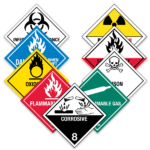 DOT Worded Placards |
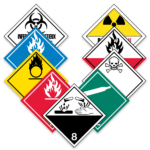 TDG / IMDG Non-Worded Placards |
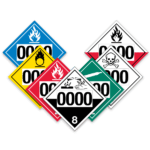 UN Numbered & Blank Placards |
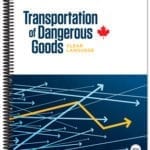 Canadian TDG Publications |


